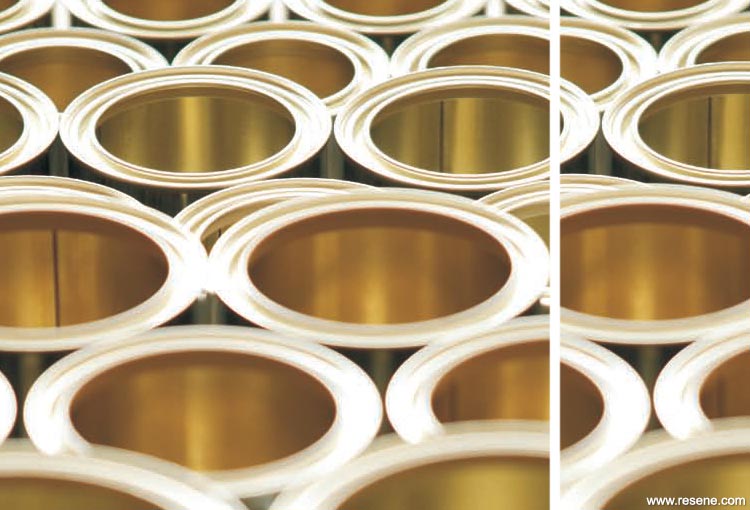From Habitat magazine - issue 01
A new coat of paint can be an instant fix. It’s cost-effective and easy to apply, and with a little planning and the right equipment, you can completely change the look of a room in a couple of days.
Resene DIY info brochures:
Ready Set Roll – Getting Started with Rollers
Brushstrokes – Getting Started with Paintbrushes
So, you’re going to lend new life to your home with a fresh coat of paint. What do you need to know before you start?
Simply calculate the surface area to be painted – don’t forget to deduct the area of windows and doors – and multiply by the number of coats you need to apply. Then, have a look on the paint container label to find out how much area the paint will cover. And don’t skimp, because spreading your paint too thinly will lower its performance.
Take the total area you are going to paint, multiplied by the number of coats, and divide this by the paint coverage. This will tell you how many litres you’ll need to buy. If the surface you’re painting is particularly irregular or porous, you are likely to need more paint.
Of course, you could jump online to and let the paint calculator on the Resene website help you do the sums.
Generally, you’re going to need to apply a primer or sealer, then two topcoats – or if you use an acrylic undercoat, one coat of the acrylic undercoat and one of the topcoat. Some colours, such as yellows, may require a third coat to get the best finish. Check the paint label and ask your ColorShop Professional for more information on when and where to use primers, sealers and undercoats.

I painted the living room ceiling using a thickish oil paint. To make life easy (or so I thought), I had the tray on a stool, so I didn’t need to come so far down the ladder. The stool was about waist-height and rectangular, in fact, perfect for the shape of the paint tray.
All was going well until my cat decided to help. He jumped up on the stool to get a better view of what was going on. He wasn’t pleased to find himself in the paint tray, jumped out and ran around the house leaving paw prints of white paint over my carpet and rugs until I could catch him.
Have you ever tried to hold a struggling cat with paws in the air to wash them with turps? I really only got one paw clean…
Sally Weatherley
There are basically five finishes available: flat, low sheen, satin, semi-gloss and gloss. The higher the gloss, the better the paint will resist stains and the easier it is to clean. However, lower gloss paints are better at hiding imperfections and are generally preferred indoors as the reduced sheen is easier on the eye. You also need to ask whether a waterborne or solventborne paint is going to be better for your requirements – in most cases, you’ll find that there is now a waterborne product ideal for the project.
Bristle brush for solventborne paints, drop sheets, extension pole, gap fillers, ladder, masking tape and paper, paint thinner or solvent (depending on whether you’re using solventborne or waterborne paint), putty, rags, roller, roller tray and roller sleeve for larger areas, sandpaper, scraper and wire brush, speed brush and synthetic brush for waterborne paints.
Very. Careful preparation of your painting surface is the single most important factor in the success of the job. Even though it may take longer than the painting itself, it’s well worth the effort. A clean, smooth, sound surface is the key to a good long-lasting finish.
Rollers are a great way to paint a large area quickly and get a professional result. Painting with a roller is fast and easy if you let the roller fabric do the work. The fabric pile on the roller will control the paint application, so you just need to provide the elbow-grease.
Good quality rollers hold more paint and give a better finish than inexpensive rollers. If you are unsure as to whether you are using the right roller, check the information on the Resene roller stand or ask ColorShop staff.
Nylon and nylon/polyester blend brushes are excellent for waterborne products, because they hold their shape and resilience. They are easy to clean and their filaments will not soften and become limp. Solventborne paints should be applied with a natural bristle brush. Either way, it’s best to opt for a higher quality brush that will hold its shape, and make sure you look after it well.
Two critical points to consider when choosing a brush are the surface you are planning to paint and the type of paint being used. It is generally best to use a variety of brush sizes - you will get better results and save time and effort. For example: Use a 88-100mm-wide flat brush with a thickness of 18-25mm for large exterior surfaces, a 75mm-wide flat brush for interior walls and ceilings, a brush with a tapered edge for cutting in corners, and a 25-63mm brush for trim and joinery.
For a little money and effort, you’ve got a whole new look. And if you got it wrong – just paint over it! Next time, you might even experiment with a whole range of different paint effects…
Search habitat magazine stories
Printed copies of habitat highlights are available from late March 2024 at Resene ColorShops and resellers, while stocks last. You can view back issues of habitat magazine online.
Specifiers:
If you have an idea, project or story that you think would suit habitat, we’d love to hear from you. Please drop us an email with your details and include photos if submitting a project.
Sign up for a DIY card and Save! Australia | New Zealand